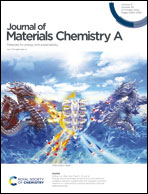A mesh-like BiOBr/Bi2S3 nanoarray heterojunction with hierarchical pores and oxygen vacancies for broadband CO2 photoreduction†
Abstract
Exploring highly efficient heterostructured photocatalysts for converting CO2 to value-added chemicals has long been pursued, which is mainly limited by inefficient visible/near-infrared (NIR) photon capture, undesirable electron–hole recombination, and insufficient accessible active sites. Herein, we report a robust heterojunction photocatalyst, consisting of mesh-like Bi2S3 nanoarrays epitaxially grown on BiOBr nanoplates via a facet-selective topotactic transformation process, for synchronically overcoming the aforementioned obstacles and markedly advancing the CO2 conversion efficiency: (i) vertically aligned Bi2S3 nanowalls harness solar photons from the visible to NIR region beyond 1000 nm and minimize the light shielding effect on BiOBr substrates, while multiple light reflection in the mesh pores enclosed by Bi2S3 walls and BiOBr supports accounts for improved light utilization efficiency; (ii) intimate coupling of BiOBr and Bi2S3 endows the heterojunction with enhanced charge separation efficiency through the interfacial Bi–S/Br–Bi bonds between them; (iii) etched pores and oxygen vacancies on the surface of BiOBr strengthen the adsorption and activation of CO2, and decrease the barrier of the rate-determining step in CO2-to-CO reduction. By virtue of these distinguished features, the optimized BiOBr/Bi2S3 heterojunction delivers an outstanding CO evolution rate of 103.5 μmol gcat−1 h−1 and selectivity of 90.1% under broadband light irradiation. This work sets up a significant milestone in simultaneously manipulating the three critical steps in photocatalysis during the construction of novel hybrid architectures for solar energy conversion applications.



 Please wait while we load your content...
Please wait while we load your content...